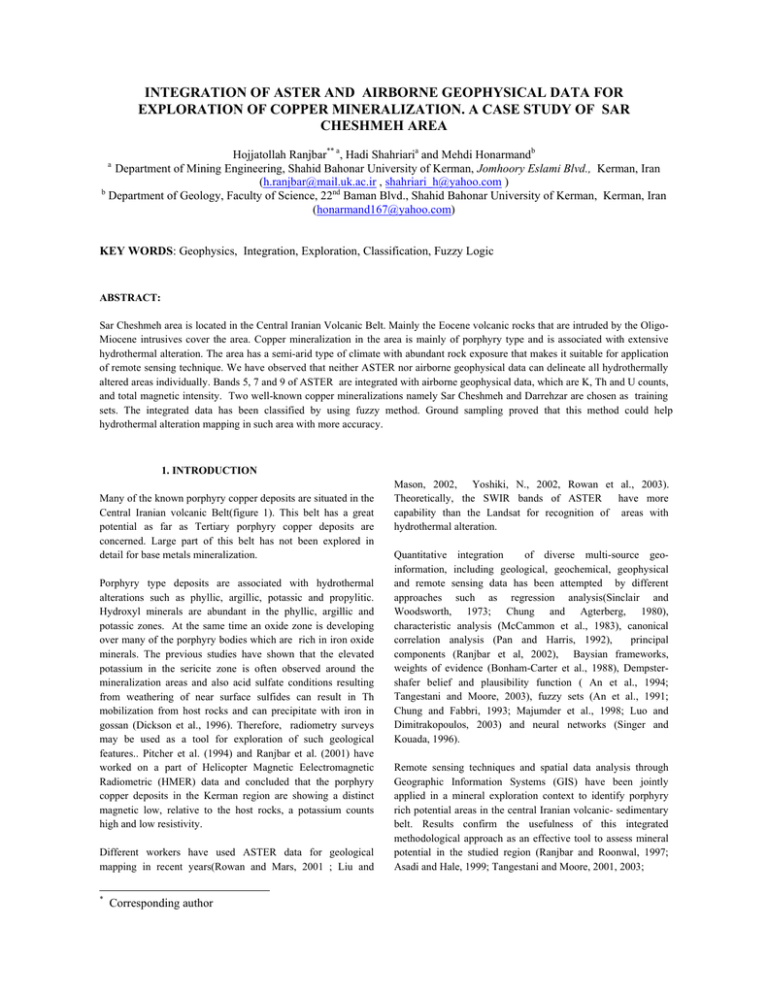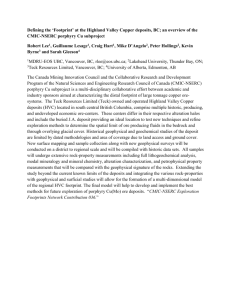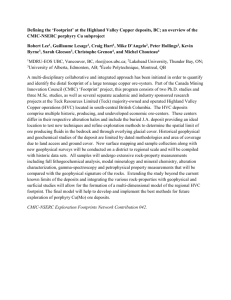INTEGRATION OF ASTER AND AIRBORNE GEOPHYSICAL DATA FOR
advertisement

INTEGRATION OF ASTER AND AIRBORNE GEOPHYSICAL DATA FOR
EXPLORATION OF COPPER MINERALIZATION. A CASE STUDY OF SAR
CHESHMEH AREA
Hojjatollah Ranjbar** a, Hadi Shahriaria and Mehdi Honarmandb
Department of Mining Engineering, Shahid Bahonar University of Kerman, Jomhoory Eslami Blvd., Kerman, Iran
(h.ranjbar@mail.uk.ac.ir , shahriari_h@yahoo.com )
b
Department of Geology, Faculty of Science, 22nd Baman Blvd., Shahid Bahonar University of Kerman, Kerman, Iran
(honarmand167@yahoo.com)
a
KEY WORDS: Geophysics, Integration, Exploration, Classification, Fuzzy Logic
ABSTRACT:
Sar Cheshmeh area is located in the Central Iranian Volcanic Belt. Mainly the Eocene volcanic rocks that are intruded by the OligoMiocene intrusives cover the area. Copper mineralization in the area is mainly of porphyry type and is associated with extensive
hydrothermal alteration. The area has a semi-arid type of climate with abundant rock exposure that makes it suitable for application
of remote sensing technique. We have observed that neither ASTER nor airborne geophysical data can delineate all hydrothermally
altered areas individually. Bands 5, 7 and 9 of ASTER are integrated with airborne geophysical data, which are K, Th and U counts,
and total magnetic intensity. Two well-known copper mineralizations namely Sar Cheshmeh and Darrehzar are chosen as training
sets. The integrated data has been classified by using fuzzy method. Ground sampling proved that this method could help
hydrothermal alteration mapping in such area with more accuracy.
1. INTRODUCTION
Many of the known porphyry copper deposits are situated in the
Central Iranian volcanic Belt(figure 1). This belt has a great
potential as far as Tertiary porphyry copper deposits are
concerned. Large part of this belt has not been explored in
detail for base metals mineralization.
Porphyry type deposits are associated with hydrothermal
alterations such as phyllic, argillic, potassic and propylitic.
Hydroxyl minerals are abundant in the phyllic, argillic and
potassic zones. At the same time an oxide zone is developing
over many of the porphyry bodies which are rich in iron oxide
minerals. The previous studies have shown that the elevated
potassium in the sericite zone is often observed around the
mineralization areas and also acid sulfate conditions resulting
from weathering of near surface sulfides can result in Th
mobilization from host rocks and can precipitate with iron in
gossan (Dickson et al., 1996). Therefore, radiometry surveys
may be used as a tool for exploration of such geological
features.. Pitcher et al. (1994) and Ranjbar et al. (2001) have
worked on a part of Helicopter Magnetic Eelectromagnetic
Radiometric (HMER) data and concluded that the porphyry
copper deposits in the Kerman region are showing a distinct
magnetic low, relative to the host rocks, a potassium counts
high and low resistivity.
Different workers have used ASTER data for geological
mapping in recent years(Rowan and Mars, 2001 ; Liu and
*
Corresponding author
Mason, 2002, Yoshiki, N., 2002, Rowan et al., 2003).
Theoretically, the SWIR bands of ASTER
have more
capability than the Landsat for recognition of areas with
hydrothermal alteration.
Quantitative integration
of diverse multi-source geoinformation, including geological, geochemical, geophysical
and remote sensing data has been attempted by different
approaches such as regression analysis(Sinclair and
Woodsworth, 1973; Chung and Agterberg, 1980),
characteristic analysis (McCammon et al., 1983), canonical
correlation analysis (Pan and Harris, 1992),
principal
components (Ranjbar et al, 2002), Baysian frameworks,
weights of evidence (Bonham-Carter et al., 1988), Dempstershafer belief and plausibility function ( An et al., 1994;
Tangestani and Moore, 2003), fuzzy sets (An et al., 1991;
Chung and Fabbri, 1993; Majumder et al., 1998; Luo and
Dimitrakopoulos, 2003) and neural networks (Singer and
Kouada, 1996).
Remote sensing techniques and spatial data analysis through
Geographic Information Systems (GIS) have been jointly
applied in a mineral exploration context to identify porphyry
rich potential areas in the central Iranian volcanic- sedimentary
belt. Results confirm the usefulness of this integrated
methodological approach as an effective tool to assess mineral
potential in the studied region (Ranjbar and Roonwal, 1997;
Asadi and Hale, 1999; Tangestani and Moore, 2001, 2003;
Geological information and data interpretations used in mineral
exploration are inherently ambiguous. The quantitave precision
or expressions like “relatively high” , “high”, “fair” , “low”, and
“relatively low” or “fairly favorable” for the mineral occurance,
as well as grey areas between these expressions, is difficult to
define.
Figure 1: Sketch map showing the position of the Central
Iranian Volcanic Belt and porphyry-type Cu deposits sub
parallel to the Zagros Thrust Zone(Shahabpour, 1994) 1Bahreasman, 2- Takht, 3- Kuhe Panj, 4- Darrehzar, 5- Sar
Cheshmeh, 6- Meiduk, 7- Gowde kolvary, 8- Darre Zereshg, 9South of Ardestan, 10- Sharif Abad, 11- Songun (Shahbpour,
1994).
Ranjbar et al., 2002 ). The aim of this study is to propose a
method for combination and analysis of the airborne
geophysical data and ASTER data for exploration of porphyry
copper deposits in this belt.
1.1 Fuzzy Set Theory for Mineral Exploration
Satellite images are classified by different methods. In this
technique pixels are assigned in groups based on their spectral
properties(Lillesand and Kiefer, 1994). The boundary of each
group is quite sharp. To do this, several training sites are
defined. Each training site is a region that contains a known
material(e.g. basaltic rock). One of the main assumption in the
traditional classification methods is that the training sites
represent pure samples of the classes they represent. But this is
rarely the case with the geological materials. But in the fuzzy
classification it is assumed that the boundaries are transitional.
Fuzzy sets are sets(or classes) without sharp boundaries; that is,
the transition between membership and non-membership of a
location in the set is gradual (Zadeh, 1965). A Fuzzy set is
characterized by a fuzzy membership grade (also called a
possibility) that ranges from 0.0 to 1.0, indicating a continuous
increase from nonmembership to complete membership. For
example, if a pixel is covered by 60% altered and 40% by
unaltered rocks , it would be considered to have a fuzzy
membership grade of 0.60 in the class of altered and a
membership grade of 0.40 in the unaltered class. Wang (1990)
has developed a method of classification of remotely sensed
data by using the fuzzy logic. The same method is used here to
classify remote sensing and geophysical data sets.
Figure 2: Geological map of Sar Cheshmeh area. 1- Recent
alluvium(Quaternary), 2- Younger gravel fan(Quaternary) , 3Calcareous terraces(Quaternary), 4- Neogene sediments, mostly
arenites with pebbles and boulders of volcanic and intrusive
rocks. Dacites and dacitic pyroclastics, 5- Oligocene-Miocene
Granodiorite, quartz diorite, diorite porphyries and monzonite,
dikes, 6- Volcanic-sedimentary complex. Trachyandesites,
trachybasalts, basaltic andesites, pyroclastics etc. (Eocene), 7Fault, 8- Working mine and copper deposit, 9- hydrothermal
alteration (After, Dimitrijevic et al., 1971).
Fuzzy set theory provides a mathematical framework to
represent the linguistic and data ambiguities frequently
encountered in mineral exploration, geological information
analysis and interpretation. The theory formally associates any
statement with a quantifiable measure indicating the degree of
possibility of the statement (Luo and Dimitrakopoulos, 2003).
The fuzzy set theory was first systematically formulated by
Zadeh(1965). A fuzzy set of A is a set of ordered pairs:
(1)
A = {(x, µA(x)|x ∈ X}
Where µA(x )A is termed the membership function or
membership grade of x in A (Zadeh, 1965). µA(x) maps X to
membership space M. When M contains only the two points 0
and 1. The range of µA(x ) is [0,1], where zero expresses nonmembership and one expresses full membership.
1.2 Study Area and Data
The geophysical data (radiometry and magnetometry) used for
this study is collected in 1977 by Prakla-Seismos GMBH on
behalf of Atomic Energy Organization of Iran(AEOI). The aim
of this survey was the exploration for uranium and thorium
minerals. An alkali Magnetometer and a radiometer have been
used on an airplane with flight line spacing chosen at 500
meters and nominal terrain clearance of 120 meters. The data
was in the form of 1:50 000 scale geophysical contour map. The
geophysical data were converted into digital form by using
onscreen digitization of contour lines. Airborne gamma ray
spectrometer data collected by the Atomic Energy Organization
of Iran, gridded to a pixel resolution of 30 meters, is used to
create digital images that show the spatial distributions of
gamma ray spectrometer data i.e. equivalent Uranium (eU),
equivalent Thorium (eTh), and Potassium (%K). Data
interpretation is traditionally made visually from hardcopy of
pseudo-coloured single-channel (figure 3).
hydrothermally altered rocks are highly fractured, and
supergene alteration has produced extensive limonite and
leaching of sulfide, giving a characteristic reddish or yellowish
color to the altered rocks. A weathered zone is developed a few
meters to 80 meters below the surface(GSI. 1973). Propylitic
and phyllic alteration are pervasive in the surface rocks with
sporadic small areas of argillic alteration. Phyllic alteration
persists below the oxidation zone, as is evident from a limited
number of samples collected from creeks. Potassic alteration is
not seen at surface, possibly as a result of an intense phyllic
overprint or surface related weathering.
In this study ASTER images (date of acquisition, Summer of
2001) have been analysed and integrated with airborne
geophysical data for proposing a model for further exploration
activities in the Central Iranian Volcanic Belt. ASTER bands
5,7 and 9 are used here. These bands show absorbtions and
reflections over altered areas, Figures 4 and 5 show ASTER
bands over an altered areas. The altered areas appear in bright
pixels in band 7, while they appear in dark pixels in band 9.
Sar Cheshmeh area is situated within the southern part of the
Central Iranian Volcanic-Sedimentary complex, southwest of
Kerman City. Its geological evolution can be simplified as (a)
formation and folding of Early Tertiary Volcanic-Sedimentary
rocks, (b) emplacement of Late Tertiary granodiorite, diorite,
quartz diorite, monzonite, and tonalite in the VolcanicSedimentary complex. Their subsequent faulting, fracturing,
alteration and mineralization, both within the porphyry rocks
and the associated volcanic rocks, followed by (c) formation of
supergene environment and oxidation zone in some of the
deposits (Dimitrijevic, 1973).
Hydrothermal alteration involving chlorite, sericite, epidote,
carbonate, silica, tourmaline and clay minerals are common.
However phyllic, argillic and propylitic alteration are more
common in the area. Volcanic-sedimentary rocks consist of
andesite, trachyandesite, trachybasalt, agglomerate and tuffs,
lava flows and sedimentary rocks. The intrusive rocks are
granodiorite, diorite and monzonite. The oldest and youngest
exposed rocks are the Lower Eocene volcanic rocks and the
Quaternary alluvial deposits and gravel fans, respectively.
Some well known copper deposits are situated in the volcanic
sedimentary belt (Figure 2).
The Darrehzar porphyry is situated in a diorite-quartz diorite
pluton of Oligocene-Miocene age that intrudes an Eocene
Volcanic-Sedimentary complex comprised mainly of
volcaniclastics, andesite, trachyandesite and sedimentary rocks.
The porphyry locally grades into granodiorite. The
Figure 3: Map shows the potassium radiometry of the Sar
Cheshmeh area
The porphyry copper mineralization at Sar Cheshmeh is
associated with a granodioritic stock intruded into a folded and
faulted, Early Tertiary volcanic–sedimentary series of andesite,
tuffs, ignimbrites and agglomerates. A potassic zone is located
in the center which has imprints of phyllic alteration. This
alteration zone is surrounded by a weak biotite and phyllic
zone. A propylitic zone, approximately 1 km thick, surrounds
the whole complex and grades into unaltered andesite. The
mineralization is occurred in the potassic, biotitized and phyllic
zones (waterman and Hamilton, 1975) .
2. DATA ANALYSIS AND DISCUSSION
Field observations have shown that, many altered areas do not
show geophysical anomalies but have a strong signature in the
satellite data. At the same time there are altered areas which
have good presence in the geophysical data but are not seen in
the satellite data. For mapping such areas, integration of
satellite and geophysical data can be helpful.
2.1 Supervised classification
The supervised fuzzy classification procedure was performed
using FUZCLASS, one of the soft classifiers available in
IDRISI for windows image processing software. Training data
chosen for each informational class was possessing pure
signature. The classification allows different levels of pixel
membership(0.00 – 1.00) and this is shown by pixel intensity:
µ= cos 2 α
(2)
Where µ is the sigmoidal membership function, α is defined as
(x-point a)/ (point b –point a) × pi /2
(3)
When x> point b, µ = 1(IDRISI, 1997).
these parts are derived from the intrusive bodies in the volcanic
area.
3. SUMMARY AND CONCLUSION
Neither satellite nor airborne geophysical data are able to map
all altered parts in the Sar Cheshmeh area individually. If both
the data are integrated together, the altered areas can be mapped
with more accuracy. The airborne geophysical data of Sar
Cheshmeh area is converted into raster format, combined with
ASTER data (bands 5, 7 and 9) and then classified, using
Fuzzy classification. Several control points are chosen in the
area. The control points are the known mineral deposits within
the area. The classified image is divided into altered and
unaltered classes. However there is no exact boundary between
the altered and unaltered classes. In the resulted image the
brighter portions are more altered areas and the darker pixels
are unaltered ones. As the satellite and airborne geophysical
data are complementary to each other, the combination of these
data is very useful for alteration mapping in the Central Iranian
volcanic Belt.
Figure 4: Band 7 of ASTER that shows altered areas in bright
pixels.
After the data integration a vector map is generated that
contains the signatures of the training areas. As the aim of this
study was to delineate the altered and unaltered parts of the
area, only two classes are chosen, namely 1)altered and 2)
unaltered. The training areas for the unaltered class are chosen
based on the field evidences. Darrehzar and Sar Cheshmeh
copper deposits, and two other known altered areas were chosen
as training areas for the altered class. The geophysical images
are integrated with ASTER data and then analysed by using
fuzzy classification . By this method the study area is classified
into altered and unaltered parts(figure 6). In this image the areas
with higher digital numbers have more membership grade that
indicates higher alteration grade. At the same time the areas that
have less alteration grade are appearing darker in this image.
The altered areas are checked in the field. Rock samples
have been collected from the area and analysed based
on XRD and thin section studies. The collected samples have
shown that the areas shown as altered parts in the volcanic
areas are sericitized and argillized. There are small areas which
are classified as altered in the sedimentary parts of the area.
This is due to the fact that the rock fragments accumulated in
Figure 5: Band 9 of ASTER that shows altered areas in dark
pixels.
REFERENCES
An, P., Moon, W. M., and Rencz, A., 1991. Integration of
geological, geophysical, and remote sensing data using fuzzy
set theory. Canadian Journal of Exploration Geophysics, 27,
pp. 1-11.
An, P., Moon, W. M., and Bonham-Carter, G. F.,1994.,
Uncertainty management in integration of exploration data
using the belief function. Nonrenewable Resources, 3, pp. 6071.
Asadi, H. H., and Hale, M., 1999, Integrated analysis of
aeromagnetic, Landsat TM and mineral occurrence data for
epithermal gold exploration in northwest Iran,
13th
International Conference on Applied Geologic Remote Sensing,
1-3 March 1999, Vancouver (Canada), p. 8.
Figure 6: Classified image of the area. The areas with higher
alteration are shown with brighter pixels in the volcanic areas.
Bonham-Carter, G. F., Agterberg, F. P., and Wright, D. F.,
1988. Integration of geological data sets for gold exploration in
Nova Scotia. Photogrammetric Engineering and Remote
Sensing, 54: 1585-1592.
Chung, C. F., and Agterberg, F. P., 1980. Regression models
for estimating mineral resources from geological map data.
Mathematical Geology, 12: 473-488.
Chung, C. F., and Fabbri, A.G., 1993. The representation of
geoscience information for data integration. Nonrenewable
Resources, 2: 122-139.
Dickson, B. L., Fraser, S. L., Kinsey-Henderson, A., 1996,
Interpreting aerial gamma-ray surveys utilizing
geomorphological and weathering models,
Journal of
Geochemical Exploration, 57, 75-88.
Dimitrijevic, M. D., 1973. Geology of Kerman region. Report
YU/52, Iran, Geological Survey of Iran, Iran.
Dimitrijevic, M. D., Dimitrijevic, M. N., Vulovic, D., 1971.
Geological map of Iran, 1:100 000 series, sheet 7149-Pariz.
Geological Survey of Iran (GSI), 1973. Exploration for ore
deposit in Kerman Region. Geological Survey of Iran Report
Yu/53, 220p.
IDRISI, 1997. Help system (online) and users manuals for
IDRISI for windows 2 Image Processing Software, Clark Labs,
Worcester, MA.
Lillesand, T. M. and Kieffer, R. W., 2000, Remote sensing and
image interpretation, 4th edition, John Wiley and Sons, New
York, pp. 585-608.
Liu, Y. G. and Mason, P. J., 2002. Hydrothermal alteration
mapping in epithermal gold deposits of Abanicos Trend,
Argentina, using ASTER data, www. Ese.ic.ac.uk (accessed
April 2004).
Luo, X., and Dimitrakopoulos, R., 2003, Data-driven fuzzy
analysis in quantitative mineral resource assessment, Computers
and Geosciences, 29, pp. 3-13.
Majumder, T., Bandopadhyay, S. and Mukherjee, R., 1998.
Fuzzy logic and its application in mineral exploration.
Proceedings of the International Symposium APCOM, Dec. 79, Western Australia, pp. 141-143.
McCammon, R. B., Botbol, J., M., Sinding-Larsen, R. and
Bowen, R. W., 1983. Characteristic analysis, 1981-final
program and a possible discovery. Mathematical Geology, 15,
pp. 59-83.
Pan. G. C. and Harris, D. P., 1992. Estimating a favourability
equation for the integration of geodata and selection of mineral
exploration targets. Mathematical Geology, 24, pp. 177-202.
Pitcher, D. H., Steele, J. P. and Watson, R. K., 1994, The
application of airborne geophysical techniques to the
delineation of hydrothermal systems in base and precious metal
deposit. Northwest Mining Association Conference, Spokane,
December, 1994, pp.1-12.
Ranjbar, H. and Roonwal, G. S., 1997, Integrated mineral
exploration for porphyry copper mineralization in Pariz area,
Kerman, Iran: a case study of the Darrehzar porphyry copper
deposit. 4th Biennial SGA meeting, 11-13 August 1997(FinlandSGA), pp. 677-879
Ranjbar, H., Hassanzadeh, H., Torabi, M., Ilaghi, O., 2001,
Integration and analysis of airborne geophysical data of the
Darrehzar area, Kerman Province, Iran, using principal
component analysis, Journal of Applied Geophysics, 48, pp. 3341.
Ranjbar, H., Honarmand, M., Moezifar, Z., Shakoori, M.,
2002, Integration and analysis of remote sensing, airborne
geophysics and geochemical data of Sar Cheshmeh area, using
directed principal component analysis. 9th International Remote
Sensing Conference(Agia Pelagia, Greece: SPIE), 23-26
September 2002, pp. 429-437.
Rowan, L. C., and Mars, J. C., 2001. Initial lithologic mapping
results using Advanced Space borne Thermal Emission and
Reflection Radiometer(ASTER) data, EOS, Transactions
American Geophysical Union, Spring Supplement, Abstract
U31A-05.
Rowan, L. C., Hook, S. J., Abrams, M. J., Mars, J. C., 2003.
Mapping hydrothermally altered rocks at Cuprite. Nevada,
using the advanced spaceborne thermal emission and reflection
radiometer (Aster), a new satellite-imaging system. Economic
Geology, 98( 5), pp. 1018-1027.
Shahabpour, J., 1994, Post- mineralization breccia dike from
the Sar Cheshmeh porphyry copper deposit, Kerman, Iran,
Exploration and Mining Geology, 3, pp.39-43.
Sinclair, A. J. and Woodsworth, G. J., 1970. Multiple regression
as a method of estimating exploration potential in an area near
Terrace, B. C. Economic Geology, 65, pp. 998-1003.
Singer, D., A., and Kouada, R., 1996. Application of a
feedforward neural network in the search for Kuroko deposits in
the Hokuroku District, Japan. Mathematical Geology, 28, pp.
1017-1023.
Tangestani, M. H., and Moore, F., 2001. Porphyry copper
potential mapping using the weights-of-evidence model in a
GIS, northern Share-e-Babak, Iran, Australian Journal of Earth
Sciences, 48, pp. 695-701.
Tangestani, M., H., and Moore, F., 2003. The use of DempsterShafer model and GIS in integration of geoscientific data for
porphyry copper potential mapping, north of Shahr-e-Babak,
Iran, International Journal of Applied Earth Observation and
Geoinformation, 4, pp. 65-74.
Wang, F. , 1990, Fuzzy supervised classification of remote
sensing images, IEEE Transactions on Geoscience and Remote
Sensing, 28, pp.194-201.
Waterman, G. C., and Hamilton, R. L., 1975. The Sar
Cheshmeh porphyry copper deposit, Economic Geology, 70, pp.
568-576.
Yoshiki, N., 2002. Rock type mapping with indices defined for
multispectral thermal infrared ASTER data: Case studies,
Proceedings of Remote Sensing for Environmental Monitoring,
GIS Applications, and Geology II, Sep 23-26 2002, Agia
Pelagia, Greece, SPIE. v 4886, 2002, pp 123-132.
Zadeh, L. A., 1965, Fuzzy sets, IEEE transactions on
Information and Control, 8, pp. 338-353.
ACKNOWLEGEMENTS
ASTER data is provided by ERSDAC of JAPAN. National
Copper Industries Co.(NICICo) of Iran has provided necessary
facilities for field checking and sampling. Geophysical data is
provided by Atomic Energy Organization of Iran. Office of
Mine and industries of Kerman Province has supported this
work.



